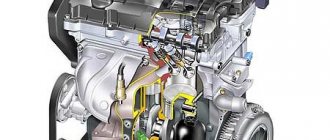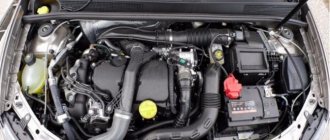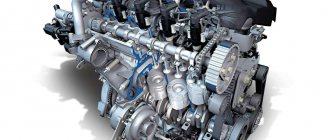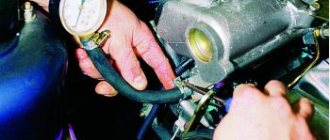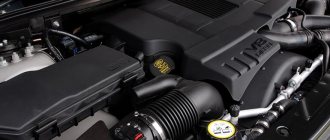Patent
The history of the invention began - based on his own calculations, Diesel wrote a small brochure on the operating principle of the engine he proposed and brought an application for his idea to the patent office.
A year later the application was granted. With a patent and brochure in his hands, Diesel began to look for a company to realize his plans. The most favorable conditions were offered by Maschinenfabrik Augsburg-Munich, or MAN for short.
Rudolf Diesel Photo: Source
The company undertook to bear all the costs of implementing the patent, and even pay Diesel an extremely high salary while he was conducting tests - 800 marks per month. MAN acquired the production rights, but without the right to assign to others.
Engine Toyota 1N-T
Toyota 1N-T
In the same 1986, a few months after the launch of the Toyota 1N engine, production of the 1N-T turbodiesel began. The piston group has not undergone any changes. Even the compression ratio was left the same - 22:1, which is due to the low performance of the installed turbocharger.
Engine power increased to 67 hp. at 4500 rpm. The maximum torque shifted to the lower speed zone and amounted to 130 N.m at 2600 rpm. The unit was installed on cars:
- Toyota Tercel L30, L40, L50;
- Toyota Corsa L30, L40, L50;
- Toyota Corolla II L30, L40, L50.
Toyota Tercel L50
Engine
Diesel immediately plunged into work. The original idea was to inject coal dust into the cylinders, which is ignited by the heat of compression. The engine must operate according to the Carnot cycle, meaning it will not have external cooling.
Already at the first attempt, Diesel discovered that some of his ideas were practically impossible to implement. Coal dust contained mineral particles that settled on the piston rings and led to catastrophic abrasive wear of the cylinders. The lack of external cooling led to the piston jamming in the cylinder.
Engine diagram drawn by Diesel Photo: Source
Diesel is a genius, he immediately discovered the flaws in the design and proposed a new cyclic process that now bears his name. I will not bore the reader with technical details, I will only say that the very first internal combustion engine operating according to this process showed amazing results.
Professor Gerlach and his assistants from the Polytechnic in Munich measured the effective coefficient of performance (COP) of a diesel engine and obtained a striking result: the effective efficiency of the new engine was almost 27%, while for a steam engine it was 3-5%, and for Otto gasoline engine - 10−12%.
In addition, the diesel engine ran on cheaper and more difficult to ignite fuel.
The principle of operation of diesel engines.
There are two options for diesel engines:
- Push-pull cycle;
- Four stroke cycle.
The most popular is the four-stroke operating cycle of diesel engines: intake (air entering the cylinder), compression (air is compressed in the cylinder), power stroke (fuel combustion process in the cylinder), exhaust (exhaust gases leaving the cylinder). This cycle is endless and is constantly repeated with mechanical precision during engine operation.
The two-stroke engine operating cycle is characterized by shortened processes, where gas exchange is carried out in purging, a single process of the mechanism. Such engines are used in marine vessels and railway transport. Two-stroke engines are built exclusively with undivided combustion chambers.
Zenith
After such success, Alfred Nobel purchased a patent for the engine for 100,000 marks. Engine manufacturers rushed to buy Diesel's patent. The inventor began to literally swim in gold.
Stationary single-cylinder diesel engine, Germany, Augsburg, 1906. Photo: ru.wikipedia.org
But it was then that Diesel missed reality. He had reached the zenith of his powers and could no longer do anything better. He created the most economical heat engine. And in a hundred or a billion years, no one will be able to surpass its efficiency, since, as theoretical calculations show, the Diesel cycle is the most economical in heat engines.
This is exactly what Diesel did not want to understand. He decided that he would always be superior to everyone, that his patents would never stop selling. But the patent can be circumvented to a greater or lesser extent, and in this case everything develops according to a different scenario. Nobody steals Diesel's ideas, but everyone improves them.
Robert Bosch creates a fuel pump that injects fuel without using compressed air, as Diesel did, and the process is incredibly simplified.
R. Diesel, K. Butz and Professor M. Schröter after a report in Kassel, 1898. Photo: Source
Metropolitan Vickers, a huge military-industrial complex in Great Britain, is creating such improvements in ship engine design that it is fundamentally different from the prototype sold by Diesel's company.
Each improvement is patented and becomes much more valuable than the main idea, whose patent protection quickly expires.
Rudolf Diesel: “I am ahead of the best minds of humanity.” The history of the creation of a diesel engine.
Home > Archive of articles from our newsletter >Issue No. 8. Article No. 1.
Print version >>
| JSC Mikhnevsky RMZ carries out repairs of diesel engines: |
| — KAMAZ-740.10/740.10 (German p.g.)/740.10 GYA — KAMAZ-740.10.03.10 (turbo) — KAMAZ-740.11-240 Euro-1 (turbo)/740.11-260 Euro-1 (turbo) — ZIL- 6454 (diesel 9.5 l)/645 (diesel 8.7 l) - YaMZ-236 (MAZ, ZIL, Ural)/ 238 (MAZ, KRAZ, Ural) - YaMZ-236NE (turbo)/238 super/240 ( K-701) - YaMZ-7511 - A-41/01 - SMD-14/17/18/22/62 - D-120/65/108/160/144/180/240/243/245/260/440 Own repair base. Bench tests. Warranty obligations. Repair prices>> |
| Rudolf Diesel |
Nowadays, the word “diesel” for most people only evokes associations with an internal combustion engine with compression ignition, running on liquid fuel. And few people know that this engine is named after the German inventor, engineer Rudolf Diesel (Diesel, 1858-1913)
Rudolf Diesel's ancestors were bookbinders and booksellers, and the family traces its ancestry to the Thuringian town of Pösneck (Germany). However, Rudolph was born in Paris on March 18, 1858.
Theodor Diesel's family lived in this city for many years, and no one remembered that they were Germans. In 1870, the Franco-Prussian War began and he had to move to England. Later the boy was sent to relatives in the city of Augsburg (Germany). There Rudolf becomes the first student of a real school, then graduates with honors from the Higher Polytechnic School in Munich. Music, poetry and the visual arts attracted Rudolph as much as mathematics.
| The young man’s performance was phenomenal, and his persistence in achieving his goal stunned his acquaintances. |
Soon, Professor Karl von Linde offered him the position of director in the Paris branch of his company. The inventor of the “Linde refrigerator” interested Diesel in the problems of heat engines - steam engines and internal combustion engines, which had just appeared thanks to the inventions of another German - Nikolaus August Otto.
Over 10 years, Diesel developed hundreds of drawings and calculations for an absorption-type engine that ran on ammonia. The young engineer’s imagination knew no bounds - from miniature motors for sewing machines to giant stationary units using solar energy! And yet, Diesel could not create, at least on paper, an efficient engine whose efficiency would be 10-12% higher than that of a steam engine.
Having set out to build an economical engine, proposed back in 1824 by the French officer Nicolas Leonard Sadi Carnot (1796-1832), Diesel carefully studied his only, immortal treatise “Reflections on the driving force of fire and on machines capable of developing this force.” According to Carnot, in the most economical engine it is necessary to heat the working fluid to the combustion temperature of the fuel only by “changing the volume”, i.e. fast compression. When the fuel ignites, you must manage to maintain a constant temperature. And this is only possible with simultaneous combustion of fuel and expansion of the heated gas.
In 1890, Rudolf moved to Berlin and... replaced ammonia with highly heated compressed air. “In the tireless pursuit of the goal, as a result of endless calculations, an idea was finally born that filled me with great joy,” wrote the inventor. “Instead of ammonia, you need to take compressed hot air, inject atomized fuel into it, temporarily expand it with combustion so that as much heat as possible can be used for useful work.”
In 1892, Diesel received a patent, which turned out to be one of the most expensive in the world. And then he published a description of the engine.
| “My idea,” he wrote to his family, “is so far ahead of everything that has been created in this area so far that we can safely say that I am the first in this new and most important section of technology on our little globe! I am ahead of the best minds of humanity on both sides of the ocean!” |
Never before have theoretical constructs aroused such great interest among specialists. However, the majority assessed the idea as practically impracticable. But there were other examples.
| “I read your work with great interest: none of all those who predicted the decline of the steam engine spoke so radically and boldly as you did. Victory will belong to such courage!” wrote Professor M. Schratter. |
Diesel believed in his car.
The first experimental engine was built already in 1893 in Augsburg. The construction was supervised by Diesel himself. We immediately began testing, and at the same time, the creation of new prototypes of the engine, which lasted over three years. During this time, three more experimental engines were built, but only the third and fourth turned out to be sufficiently efficient, but not to the same extent.
According to the inventor's plan, the first engine was supposed to use lignite dust as fuel and operate without water cooling of the cylinder walls.
Having failed to achieve a positive result with coal dust, Rudolf Diesel, after attempting to use illuminating gas, finally opted for liquid fuel. Although it was not possible to achieve the expected results during testing, some new prerequisites were obtained for the creation of the next prototype engine.
In February 1894, tests began on the second experimental engine, which idled steadily without load.
After the first two failures, he designed a third model. “The first engine doesn’t work, the second works imperfectly, the third will be good!”
- Diesel said to his colleague Vogel.
In 1895, the assembly of the third sample was completed, containing all the main elements of the future diesel engine. He turned out to be really good! But when creating it, Diesel had to abandon many of his original ideas. For example, he was completely unable to achieve the expected results from operating the engine without water cooling. Although the possibility of such work, predicted by Diesel theoretically, was proven during tests, experiments convinced him that it was impractical to implement this in practice. Positive results appeared only after the engine was equipped with water cooling, and liquid fuel was supplied into the cylinder and atomized using compressed air.
Regarding the introduction of water cooling, Diesel later, explaining the operation and test results of the first experimental engine in his report at the congress of the Union of German Engineers, will say the following:
“I would like to draw your attention to the fact that this machine worked without a water jacket and that, thus, the possibility of working without water cooling, as envisioned theoretically, was proven. For practical reasons, in further developments of the machine, a water cooling jacket was used, which visually makes it possible to obtain more work with the same cylinder dimensions. Based on the extensive experience gained in testing, it became completely clear to me that the point of view that the water jacket in internal combustion engines is the main obstacle to achieving higher efficiency is incorrect.”
| At the end of 1896, the final, fourth version of the experimental engine with a power of 20 hp was built. (about 15 kW). |
During official tests in February 1897, conducted under the direction of Professor M. Schröter, this engine consumed 0.24 kg per 1 hp. per hour of kerosene, its effective efficiency was 0.26, and its thermal efficiency was 0.29. None of the engines that existed before that time had such indicators.
The engine operated in four strokes. During the first stroke of the piston, air was sucked into the cylinder, during the second it was compressed to approximately 3.5-4 MPa, heating up to approximately 600°C. At the end of the second stroke of the piston, liquid fuel began to be introduced into the medium of compressed (heated by compression) air through an air-spray nozzle (compressed air under a pressure of 5-6 MPa) (kerosene was used in the tests). Entering the heated air environment, the fuel self-ignited and burned at almost constant pressure (but not at a constant temperature, as Diesel expected when patenting the cycle) as it was fed into the cylinder, which lasted approximately 1/5-1/ of the third stroke of the piston. During the rest of the piston stroke, combustion products expanded. During the fourth stroke of the piston, the exhaust combustion products were released into the atmosphere. The operating cycle of the created engine was very different from the patented one.
In 1897, the first practical diesel engine was created at the Augsburg plant. The unit, three meters high, developed 172 rpm and, with a single cylinder diameter of 250 mm and a piston stroke of 400 mm, produced from 17.8 to 19.8 hp, consuming 258 g of oil per 1 hp. at one o'clock. At the same time, the thermal efficiency was 26.2% - twice as high as that of a steam engine. VICTORY!
The 1898 steam engine exhibition in Munich was the culmination of Diesel's incredible success. Licenses for engine production were sold in great demand by German and foreign companies.
A golden rain fell on the 39-year-old engineer!!!
Having abandoned research, Diesel turned to commerce. Already possessing a six-million dollar fortune, he founded an enterprise for the construction of electric trains, financed Catholic lotteries, and bought and sold all kinds of companies. But amazingly, not a single engine of the “Diesel system” had even been sold by that time!
A scandal erupted when the first diesel engines failed to operate. Agreements are cancelled, payments to Diesel are suspended. The Augsburg factory owned by the inventor went bankrupt. Due to the abundance of minor problems, the diesel engine undermined its reputation. The required precision in the manufacture of a number of parts significantly exceeded the level of capabilities of most factories. In addition to technological difficulties, the question arose of creating new heat-resistant materials. Some diesel engines for mass production...
Faced with a wall of hostility in Germany, Diesel established relationships with foreign industrialists. In France, Switzerland, Austria, Belgium, Russia and America, he found a more cordial welcome than in his historical homeland.
| In 1898, Emmanuel Nobel, highly appreciating the prospects of Diesel’s invention, immediately reoriented the production of the St. Petersburg Nobel plant to their production. |
In the same year, with his participation, the world's first engine with internal mixture formation was built, which differed from Diesel's invention. In 1899, the first engine was put into operation. And in 1900, the plant had already produced 7 such engines, each with a power of 30 and 40 hp. By 1912, the plant employed about 1,000 workers, producing more than 300 engines per year.
Russian Diesel engines were installed at the city’s power plants and at the pumping station of the St. Petersburg water supply system. With their help, the Eliseev Trading House on Nevsky Prospekt was illuminated
. He dedicated his report at the famous conference in St. Louis (USA) in 1912 to the brilliant future of diesel engines, without saying a word about the difficulties, mistakes and failures with which his invention came to life.
“An invention... has never been just a product of creative imagination: it is the result of a struggle between abstract thought and the material world... The history of technology considers an inventor not the one who, with varying degrees of certainty, previously expressed similar thoughts and ideas, but the one who realized your idea, which flashed, perhaps, in the minds of many other people..."
Diesel had good reasons for such statements. The appearance of an engine that was inexpensive to operate meant the victory of oil over coal, and this did not please the owners of the coal-mining Ruhr: “Diesel didn’t invent anything... he just collected inventions...”
| Despite the successes of the new type of engine, the attacks of ill-wishers against Rudolf Diesel and his engine did not weaken, and even intensified. |
Professor Lueders, who was previously known for his poisonous critical articles against Diesel, prepared an entire printed work of 236 pages for publication, calling it “The Diesel Myth.”
In it, Lüders, cruelly castigating Diesel, sought to prove that the engineer Diesel himself had not invented anything and everything on which the work of the “high-compression heat engine” was based was known before, and also that the engine built by Diesel did not correspond to the ideas that he patented it and was going to implement it.
The book cited a number of technical errors and blunders of Diesel. Based on all this, Lueders, exaggerating to the extreme, accused Diesel of insufficient technical literacy. A loud scandal was looming. Lüders' book was expected to be published in October 1913.
| On the night of September 29-30 of the same year, 1913, Rudolf Diesel died tragically. |
Diesel's biographers consider the main reason for his death to be the impending humiliating blow, which he learned about from the publishers of Lueders' book. In this approaching scandal, Rudolf Diesel would not be able to put forward strong arguments against Lüders to refute his attacks, but could only declare that Lüders had exaggerated his colors to the extreme. By this time, Diesel’s financial affairs were also shaken.
What details of the tragedy do Diesel’s biographers report, and what other facts did they base their conclusions on the reasons for his death?
To verify the validity of their arguments, let us turn to the events of the last year of the inventor’s life.
In 1912,
when, it would seem, everything was still fine, Rudolf Diesel comes to America.
The world's engineering community is accustomed to seeing him as a major, successful specialist at the zenith of his fame; it is not without reason that New York newspapers notified their readers of the arrival of “Dr. Diesel, the famous certified engineer from Munich.” In the lecture halls where he gave presentations, in hotel lobbies and theater foyers - everywhere he was besieged by correspondents. Edison himself, the sorcerer of American invention, then publicly declared that Rudolf Diesel's engine was a milestone in the history of mankind. Correct, reserved, dressed in a strict black tailcoat, Diesel stoically endured long and stilted performances to his audience. And not a single one of the American engineers who listened to his speech could even suspect then that the brilliant speaker, speaking in excellent English about the prospects of his engine, was in a desperate situation, close to complete collapse.
True, it was noted that he dedicated his famous lecture in the vast hall of St. Louis to the future of his engine, but did not say a single word about the difficulties, mistakes, failures, attacks and mistrust with which his invention came to life. And at the same time, foreseeing or sensing the inevitability of his collapse, immediately upon returning to Munich, Diesel, using borrowed money, buys shares in an electric car company, which soon went bankrupt. As a result, he had to pay off almost all the servants and mortgage the house in order to implement his latest plan, which no one was privy to.
Diesel started the next year on the road:
At first he visited Paris, Berlin, Amsterdam alone, and then together with his wife he visited Sicily, Naples, Capri, Rome.
| “We can say goodbye to these places. We will never see them again." |
He dropped such a strange phrase once, and his wife did not pay attention to it then, but remembered and understood it only later, when everything had already happened. Then Diesel travels to the Bavarian Alps to visit Sulzer, at whose factory he once underwent engineering practice. Old friends were struck by the changes that had recently occurred with Rudolf. Always reserved and cautious, he seemed to have lost these qualities without a trace and with visible pleasure sought dangerous mountain journeys and indulged in risky activities.
By the end of the summer of 1913, a financial crisis broke out. Diesel became completely bankrupt.
And at this moment, having recently refused well-paid positions in American companies, he suddenly agrees to the offer of a new engine plant in England to take up the position of just a consulting engineer.
Having learned about this, the British Royal Automobile Club asked him to make a report at one of the club meetings, to which Diesel also agreed and began preparing for a trip to England. In this short period of time, he commits some actions, analyzing which later, those close to Rudolf Diesel will come to the conclusion that he had already made a tragic decision.
Having taken his wife to visit his mother, he was left alone in his Munich house by the beginning of September. The first thing he immediately did was to dismiss the few remaining servants from the house until morning and ask his eldest son (also Rudolf) to urgently come to him. According to the son's recollections, it was a strange and sad meeting. His father showed him what was in the house and where, in which cabinets important papers were stored, gave him the appropriate keys and asked him to try out the locks. After his son left, he began looking through business documents, and the servants who returned the next morning found that the fireplace was filled with the ashes of burnt papers, and the owner himself was in a gloomy, depressed state.
A few days later, Diesel left for Frankfurt to visit his daughter, where his wife was already waiting for him. After staying with them for several days, he left alone on September 26 for Ghent, from where he sent a letter to his wife and several postcards to friends. The letter was strange, disturbed and indicative of his great distress or illness, but, unfortunately, Diesel mistakenly wrote his Munich home address on the envelope. The wife received the letter too late.
Together with two of his colleagues and friends on the evening of September 29 in Antwerp, Diesel boarded the Dresden ferry, sailing across the English Channel to Harwich.
| In the evening, after dinner at a restaurant and an excellent cigar, he wished his companions good night and retired to his cabin. No one ever saw him again... |
An inspection of the cabin showed: the bunk prepared by the steward for sleeping was not even crumpled; the luggage is not opened, although the key is inserted into the suitcase lock; Diesel's pocket watch was placed so that the hands could be seen while lying on the bed; The notebook lay open on the table and the date September 29 was marked with a cross in it. It turned out immediately that during the morning round of the ship, the officer on duty found someone's hat and folded coat stuffed under the rails. It turned out that they belonged to Diesel.
Only ten days later the crew of a small Belgian pilot boat recovered a corpse from the waves of the North Sea. The sailors removed the ring from the swollen fingers of the deceased, found a wallet, a case for glasses, and a pocket first aid kit in his pockets, and the corpse, following maritime custom, was buried at sea. The son of Rudolf Diesel, who arrived in Belgium on call, confirmed that all these things belonged to his father.
Diesel's relatives were convinced that he had committed suicide. This version was supported not only by Diesel’s strange and incomprehensible behavior in the last year of his life, but also by some circumstances that later became clear. So, before his departure, he gave his wife a suitcase and asked not to open it for several days. There were 20 thousand marks in the suitcase. This was all that remained of Diesel's enormous fortune. Or again: when going to England, Diesel took with him not a gold watch, as usual, but a steel pocket watch...
But if this is suicide, then why, some biographers ask, did Rudolf Diesel, always punctual and scrupulous in any formalities, leave neither a will nor even a note? Why, even on the eve of his death, did he discuss with interest some issues important to his career, and a few hours or even, perhaps, minutes before his disappearance, he enthusiastically spoke with his comrades about the details of his upcoming performance at the car club? Apparently, no one will ever be able to answer these questions.
The disappearance of Rudolf Diesel from the Dresden ferry, like any mysterious and tragic event, gave rise at one time to many versions of the reasons for his death: - There was, for example, an assumption that Diesel was removed by the German General Staff, who feared on the eve of the war that information about the engines would be transferred to the British, built for German submarines
.
— There were rumors about Ludwig Nobel’s involvement in this tragedy.
It was also suggested that Diesel was simply washed overboard by a wave when he went on deck at night. This is where we will end the story of the triumph of the outstanding engineer-inventor Rudolf Diesel and his difficult personal tragedy, the tragedy of a courageous, but, as it turned out, extremely vulnerable man. He embodied in his engine the previously accumulated world experience in engine building, the implementation in it of many not yet implemented ideas, and in general the creation of a new type of engine, which became a milestone in energy and transport engineering.
| Humanity gave Rudolf Diesel a high and rather rare honor in the history of technology by starting to write his name with a small letter. |
The article uses materials from the specialized magazine “Construction Equipment and Technologies”,
“Remembering names.
Rudolf Diesel" S.I. Kornyushenko, No. 4(38)2005 and resource materials https://www.infoflot.ru
Sunset
Rudolf Diesel gave the green light to powerful diesel engines, but earned the hatred of both his fellow engine engineers and the most influential force at the time - the coal companies.
During the period 1904-1905, the price of oil increased 2.5 times, and profitability increased more than 7 times. This directly influenced many interests. The hardest hit were German industrialists, who owned the largest coal reserves at the time. Germany lost its superiority over England, and Diesel was blamed for it.
Industrialists began a subversive war against the inventor: they led his enterprises to bankruptcy, and he lost a huge part of his investments. Enemies tried to destroy him morally, investing huge amounts of money in propaganda, claiming that he was not the father of his invention, but borrowed other people's ideas.
Financially, his opponents defeated him, but Diesel was left with recognition in the scientific world, which refuted the slander against him.
Other names
In parallel with Diesel, the development of a new engine was led by Russian engineer Gustav Trinkler. He introduced his engine with a similar high-pressure system, the Trinkler Motor, a year late compared to Diesel and, despite the competitor’s superiority in terms of efficiency and technological excellence, was not successful. The fact is that by that time the largest corporations and factories had bought patents for the production of Diesel system engines for huge amounts of money - it was in their interests to hide the development of the Putilov plant.
As for the technological refinement of the Diesel engine, it was taken up in 1909 by Benz&Cie plant engineer Prosper Lerange. He not only invented the engine prechamber, but also designed needle valve injectors and the first unit injectors.
Solidarism
Around the same time, Diesel began to study social theories and created the work “Solidarism. Natural economic liberation of people." It explains the possibility of a society in which the majority of members own their own small businesses. Such a society will avoid revolutions, riots, unrest, victims and is doomed to prosperity, thought Diesel.
Rudolf Diesel Photo: wikipedia.org
This theory did not find much support in the turbulent years before the First World War and the coming revolution. Diesel spent most of the money received as a result of the invention of the diesel engine to promote his theory.
Berlin branch
After partially restoring his vision in a Paris clinic, Rudolf, at the invitation of his teacher Karl von Lind, headed the Berlin branch of the company. Inspired by the success, Rudolf Diesel creates an industrial prototype of the engine, which was a commercial success. The inventor called the new power plant an atmospheric gas engine.
However, this name did not stick for long, and the invention began to be called simply “diesel” in honor of the creator of the unit. Numerous contracts, financial flows and steady demand for a new invention force Diesel to leave the Carl von Linde branch and open his own diesel engine plant.
End
Thus, after several years of grueling struggle, Rudolf Diesel reached a dead end. It was necessary to marry off my daughter, but there was no money for a dowry. On September 19, 1913, he boarded a ship to go to England and disappeared. Three days later, a body identified as Diesel was caught in fishing nets in the North Sea.
Murder? Hardly - no motive. Suicide? May be. There are plenty of reasons: complete financial collapse, huge unpaid obligations. Nevertheless, the death of Rudolf Diesel remains one of the biggest mysteries of the modern world. Whether anyone will reveal it, we can only guess.
Maybe you'll take it?
Tags: engineer, inventor, engine, inventions, Rudolf Diesel, history of invention, internal combustion engine
World crisis
The largest engineering companies in Europe and the United States of America were queuing up to purchase licenses for the production of diesel engines. The world press constantly fueled interest in Rudolf Diesel's invention, giving flattering characteristics to the advantages of the new unit over other power plants.
R. Diesel became very rich. Alphonse Busch, an American beer magnate, offered the designer one million dollars for the right to manufacture engines in the United States. But it all ended overnight.
In 1913, a global crisis broke out. Inept distribution of financial flows led to the gradual bankruptcy of Diesel's enterprises.
Two new heat engines
At the end of the 19th century, working on engines seemed to be a very innovative activity. In Otto engines, illuminating gas has already begun to be replaced with very promising hydrocarbons - gasoline. However, there remained kerosene, diesel fuel, fuel oils and gas oils that were not yet used in engines and were used only as heating fuel. Experiments with them showed that they are quite suitable as a working fluid and can well replace gas and gasoline to drive heat engines using a crank-connecting rod circuit with a crosshead mechanism. The main advantage of kerosene and diesel fuel was the ignition of the working mixture from compression. This simplified the design of the engine, and in theory gave a higher effect than in engines with spark and capricious engines with glow ignition.
The method of using new waste fuels was of interest not only to Diesel, and therefore it did not take long to look for new allies among the emerging industrial aristocracy of Germany. One of the protégés who believed in Diesel’s lucky star and showed maximum patience during his experiments was Heinrich von Butz, the owner of the MAN Augsburg engineering plant.
On February 27, 1892, Diesel applied for a patent for a “new rational heat engine”; it was registered a day later. At the same time, von Butz persuades the Krupp and Sulzer Brothers Ltd R. companies to participate financially in Diesel’s experiments to create a new engine. An annual salary of 30 thousand marks and investments of 600 thousand marks made it possible to create a workable experimental engine “A” within a year. By this time, the 34-year-old inventor, number 67207, had been issued a patent at the Imperial Patent Office in Berlin entitled “Method and apparatus for converting high temperature into work.” The second patent with a modified Carnot cycle was registered on November 29, 1893. And in February 1894, tests began on the second experimental engine “B”, which for the first time in history idled steadily.

